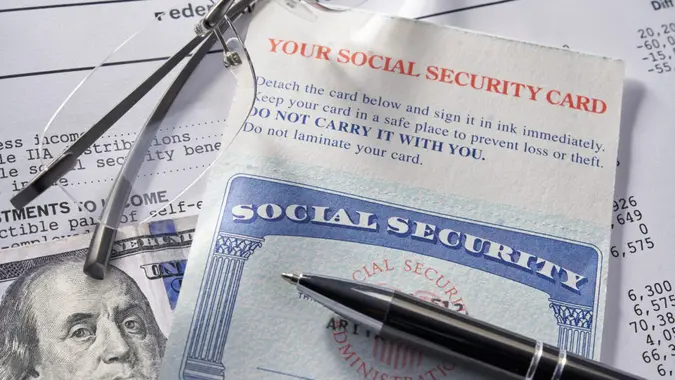4 Things To Do Before You Retire If You Won’t Get Social Security Benefits

Commitment to Our Readers
GOBankingRates' editorial team is committed to bringing you unbiased reviews and information. We use data-driven methodologies to evaluate financial products and services - our reviews and ratings are not influenced by advertisers. You can read more about our editorial guidelines and our products and services review methodology.

20 Years
Helping You Live Richer

Reviewed
by Experts

Trusted by
Millions of Readers
While Social Security was never intended to fully fund retirement, it does provide at least a basic income for a large majority of retirees. In fact, according to the Social Security Administration, nearly 97% of Americans 60 or older either receive or will receive Social Security benefits, with the average monthly benefit reaching $1,860.23 in Jan. 2024.
If you’re heading for retirement and you think you’re not going to get benefits, you’ll have to make up this income shortfall if you want to maintain your standard of living. Here are some steps you should consider taking before you retire if you’re not in line to receive Social Security benefits.
Learn Where You Stand
To qualify for Social Security retirement benefits, you’ll need to earn 40 “quarters of coverage.” While the specifics are a bit quirky, essentially you’ll qualify if you work and pay into the Social Security system for at least 10 years.
However, even if you assume you won’t get benefits in this traditional way, you may be surprised to learn that there are other ways you might qualify for retirement benefits. This is why it’s essential to learn where you really stand before you make any assumptions about your lack of benefits.
For example, if you’re married to a worker who is entitled to benefits, you may be able to receive spousal benefits yourself, even if you never worked a day in your life. If you wait until your full retirement age, you may qualify for a benefit equal to 50% of what your spouse receives. Perhaps surprisingly, you may qualify for this benefit even if you are divorced, as long as you were married for 10 years and meet some other requirements.
If you’re the survivor of a decedent who was receiving benefits, you’re also likely entitled to benefits yourself, even if you don’t qualify on your own work record. If you’re a surviving spouse who has reached full retirement age, you may be entitled to 100% of the benefits that your deceased spouse was earning.
So, it’s certainly worth educating yourself and contacting the SSA about what your benefits in retirement might be, even if you don’t qualify based on your own work record.
Maximize Retirement Plan Contributions
If you’re really not going to be receiving any Social Security benefits, then you’ll need to do the heavy lifting yourself when it comes to funding your retirement. The best way to accomplish this is through your retirement plan contributions.
If your employer sponsors a 401(k) plan, for example, you can reduce your taxes by making contributions and you can benefit from tax-deferred growth. Best of all, contribution limits for 401(k) plans are high. In 2024, for example, you can sock away up to $23,000 in a 401(k) plan. Even better, if you’re age 50 or older, you can make a “catch-up” contribution up to an additional $7,000, making your total possible contribution a whopping $30,000.
If you can manage to set aside $30,000 per year for 10 years starting at age 50, with a 10% annual return you’ll have over $500,000. That’s a significant sum in just 10 years of saving. If you continue investing money until age 65 instead of 60, you’ll have over $1 million. This can go a long way to making up for your shortfall in Social Security income.
Check for Pension Plan Eligibility
If you ever worked for a major employer, it’s worth checking if you’re entitled to any pension plan benefits. While most large companies used to offer pensions to workers, those have been largely phased out in favor of 401(k) and other retirement plans.
But if you’re nearing retirement age, it’s entirely possible that at one point you worked for an employer with a pension and may be vested in benefits. Check your records and contact former employers to see if you’re entitled to any type of pension payments upon your retirement. In some cases, an ex-employer may offer to pay you out in a lump sum, which you can transfer tax-free to a plan like an IRA.
Adjust Your Retirement Budget
If after you’ve exhausted all your options you’ll still be coming up short in retirement, you’ll have to adjust your budget. With less income available to fund your dreams, you’ll need to make some hard choices so that you can be in a better financial position by the time you retire.
Start by trimming discretionary expenses like eating out and subscription services, and cut any lavish vacations from your budget as soon as possible. You may have to make difficult money moves, but if you get creative you can still build up a big enough nest egg to enjoy retirement.
Consider options like downsizing your home or even relocating to a more affordable area so that you can stretch your monthly budget and have more cash available to invest. Picking up a side gig can also provide more income and perhaps even grow into a lucrative business by the time you retire.
A combination of these choices may be all that you need to make up for the fact that you won’t be receiving Social Security benefits when you retire.
More From GOBankingRates
 Written by
Written by  Edited by
Edited by 

























